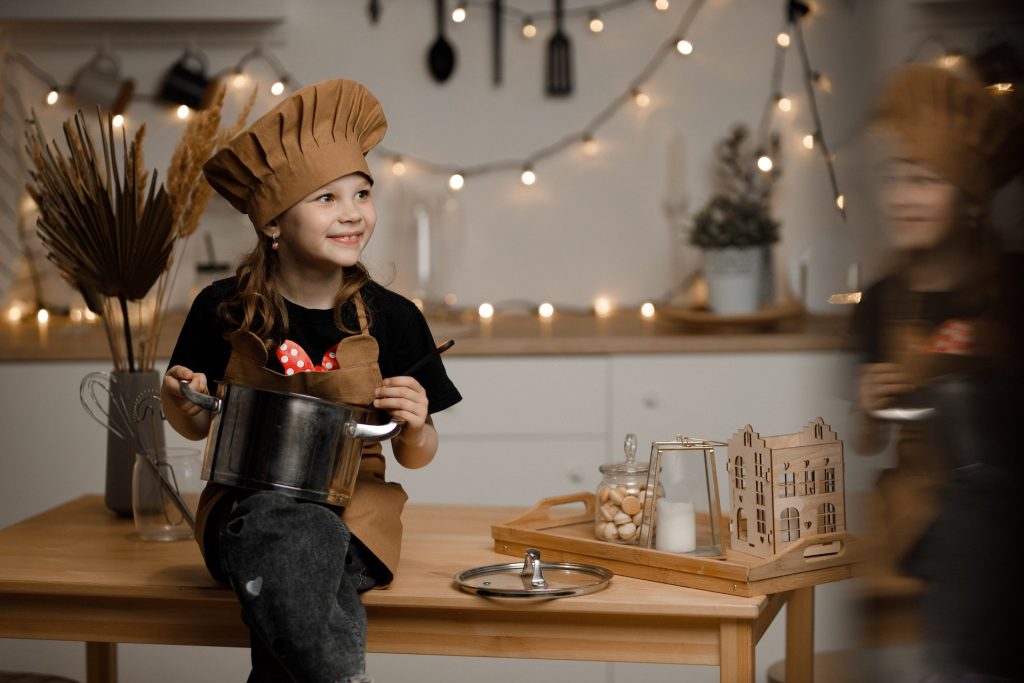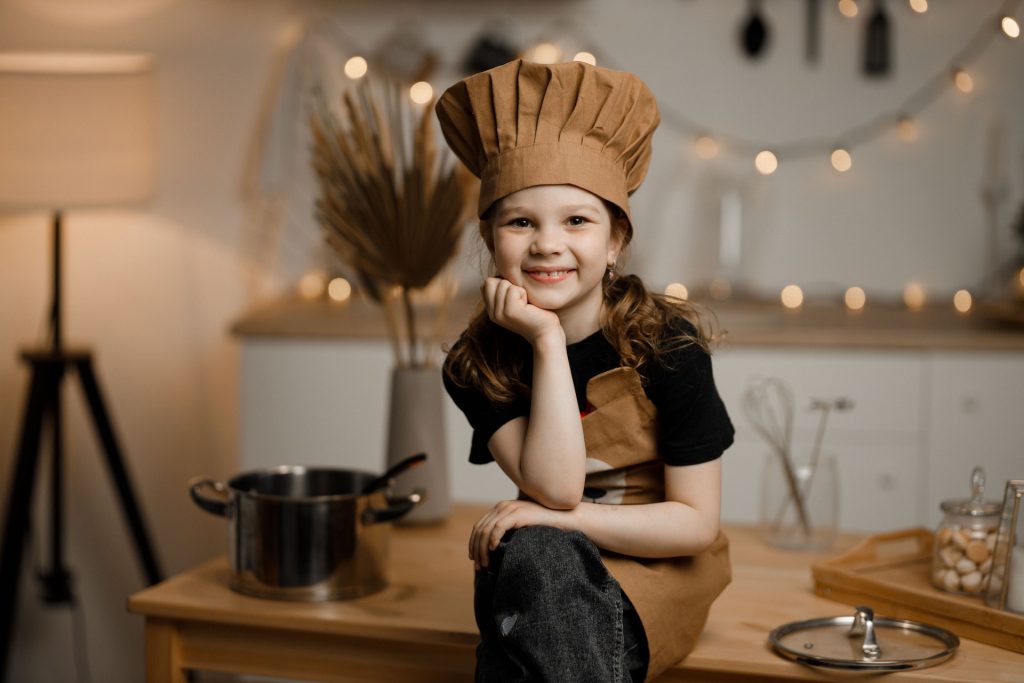Discover the ultimate step-by-step guide to teaching cooking to 7-8 year olds.
Teaching Cooking to 7-8 Year Olds: A Step-by-Step Guide
Teaching cooking skills to children is not only a fun and interactive way to spend time together, but it also plays a significant role in their development. As a parent or educator, taking the time to teach kids how to cook can have lasting benefits. In this step-by-step guide, we will explore the importance of teaching cooking skills to 7-8 year olds and provide helpful tips to make the experience enjoyable and educational.
Understanding the Importance of Teaching Cooking Skills to Children

Before we dive into the practical aspects of teaching cooking to young kids, let’s take a moment to understand why it is so important. Cooking is a life skill that goes beyond preparing meals. It fosters creativity and expands children’s palates, encourages them to make healthier food choices, and promotes cognitive development.
Cooking with children is not just about following a recipe and creating a delicious dish. It is a valuable opportunity to teach them about the importance of nutrition and how to make informed food choices. By involving them in the cooking process, you can help them develop a deeper understanding of the ingredients they use and the impact those ingredients have on their bodies.
When children actively participate in cooking, they are more likely to develop a positive relationship with food. They become aware of the variety of flavors and textures that different ingredients offer, which can expand their palates and make them more open to trying new foods. This exposure to a wide range of ingredients can also help them develop a preference for healthier options, such as fruits, vegetables, whole grains, and lean proteins.
The Benefits of Cooking for Cognitive Development
Cooking engages children’s minds in various ways. From reading and following recipes to measuring ingredients and observing chemical reactions, kids are constantly learning and problem-solving. These activities help enhance their reading comprehension, math skills, and critical thinking abilities.
When children read recipes, they are practicing their reading skills and learning new vocabulary. They have to follow step-by-step instructions, which improves their ability to understand and follow directions. Measuring ingredients requires them to use math skills, such as counting, fractions, and measurements. They also get to witness the science behind cooking, as ingredients transform and react to heat and other elements.
Furthermore, cooking encourages creativity and imagination. Children can experiment with different flavors, spices, and cooking techniques, allowing them to express themselves and develop their own unique culinary style. This creative outlet can boost their self-confidence and inspire them to think outside the box in other areas of their lives as well.
Promoting Healthy Eating Habits Through Cooking
By involving children in the cooking process, you have the opportunity to introduce them to a wide range of nutritious ingredients. Exploring fruits, vegetables, whole grains, and lean proteins can encourage them to try new foods, broaden their palettes, and develop healthy eating habits from an early age.
When children are actively involved in meal preparation, they are more likely to develop a positive attitude towards healthy foods. They become invested in the outcome of the meal and are more willing to try new flavors and textures. This hands-on experience also allows them to understand the nutritional value of different ingredients and make informed choices about what they eat.
Moreover, cooking can be a great way to teach children about portion control and balanced meals. By discussing the importance of including a variety of food groups in each meal, you can help them develop a well-rounded approach to nutrition. They can learn about the different food groups and how they contribute to their overall health and well-being.
Building Confidence and Creativity in the Kitchen
Allowing children to take an active role in the kitchen can boost their self-esteem and creativity. By giving them age-appropriate tasks, such as stirring, measuring, or decorating, you are empowering them and instilling a sense of accomplishment. This newfound confidence may extend to other areas of their lives as well.
When children contribute to the cooking process, they feel a sense of ownership and pride in the final outcome. They can see the direct results of their efforts and feel a sense of accomplishment. This positive experience can build their self-confidence and motivate them to take on new challenges.
Cooking also provides an outlet for creativity. Children can experiment with different flavors, colors, and presentations, allowing them to express themselves and develop their own unique culinary style. This creative freedom can spark their imagination and encourage them to think outside the box in other aspects of their lives.
In conclusion, teaching cooking skills to children is not only about preparing meals. It is an opportunity to foster creativity, expand their palates, promote healthy eating habits, and enhance their cognitive development. By involving children in the kitchen, we can empower them to make informed food choices, develop essential life skills, and build confidence that extends beyond the realm of cooking.
Preparing for the Cooking Lesson
Before embarking on your cooking adventure, it is essential to make thorough preparations to ensure an enjoyable and safe experience for everyone involved.
Preparing for a cooking lesson can be an exciting and rewarding experience. It allows you to teach valuable skills to children while fostering their creativity and love for food. By following a few key steps, you can ensure that the cooking lesson goes smoothly and is a memorable experience for all.
Safety Measures to Consider
Safety should always be a top priority when cooking with children. Establish clear guidelines about using knives, handling hot surfaces, and understanding basic kitchen safety rules. Emphasize the importance of washing hands regularly and wearing appropriate clothing, such as an apron and closed-toe shoes.
When it comes to cooking with children, safety is paramount. Taking the time to educate them about potential hazards and how to prevent accidents is crucial. By instilling good safety habits from an early age, you are setting them up for a lifetime of safe and enjoyable cooking experiences.
Choosing Age-Appropriate Recipes
Selecting recipes that are suitable for 7-8 year olds is key to keeping them engaged and interested. Opt for recipes with simple steps, minimal cooking equipment, and familiar ingredients. Pizza making, salad assembling, and sandwich crafting are great starting points that offer room for creativity.
When choosing age-appropriate recipes, it’s important to consider the skill level and interests of the children. By selecting recipes that are easy to follow and involve ingredients they enjoy, you can ensure that they stay engaged throughout the cooking lesson. This will not only make the experience more enjoyable for them but also increase their confidence in the kitchen.
Gathering Necessary Tools and Ingredients
Prior to the cooking lesson, gather all the tools and ingredients needed. Review the recipe to ensure you have everything on hand. Consider creating a designated cooking area that is easily accessible and allows for safe movement around the kitchen. Having everything readily available will make the experience smoother and more enjoyable.
Gathering the necessary tools and ingredients ahead of time is essential for a successful cooking lesson. It allows you to focus on teaching and guiding the children rather than scrambling to find missing items. By organizing your cooking area and having everything within reach, you can create a stress-free environment that promotes learning and creativity.
Preparing for a cooking lesson involves more than just gathering ingredients and tools. It requires careful consideration of safety measures, choosing age-appropriate recipes, and creating a conducive environment for learning. By taking the time to prepare thoroughly, you can ensure that the cooking lesson is not only educational but also a fun and memorable experience for everyone involved.
Conducting the Cooking Lesson
Now that you have made the necessary preparations, it’s time to embark on your cooking adventure with the kids!
Before diving into the cooking process, it’s important to create a welcoming and engaging environment for the children. Set up the cooking area with colorful aprons, kid-sized cooking utensils, and a variety of fresh ingredients. This will not only make the experience more enjoyable but also stimulate their curiosity and creativity.

Breaking Down the Cooking Process
Start by explaining the cooking process step by step. Break each task down into manageable parts, allowing the children to focus on one task at a time. For example, if you are making homemade pizza, explain how to prepare the dough, chop the toppings, and assemble the pizza.
When explaining each step, provide interesting facts and stories related to the ingredients or cooking techniques. For instance, you can share the history of pizza and how it originated in Italy. This will not only make the lesson more informative but also spark their interest in different cultures and cuisines.
Encouraging Active Participation
Children learn best through hands-on experiences. Encourage them to actively participate in every stage of the cooking process. Let them measure ingredients, mix dough, and sprinkle toppings. Provide guidance and support, but also allow them to explore and experiment on their own.
To make the cooking lesson more interactive, you can turn it into a friendly competition. Divide the children into teams and challenge them to create their own unique pizza recipes. This will not only foster teamwork but also ignite their creativity and problem-solving skills.
Explaining Cooking Terms and Techniques
As you cook together, take the opportunity to introduce cooking terms and techniques. Explain what sautéing, simmering, and grating mean. Demonstrate and guide them through different cooking methods. Encourage their curiosity by answering questions and fostering a sense of culinary exploration.
In addition to explaining the terms, you can also share interesting trivia about the techniques. For example, you can explain how sautéing helps to enhance the flavors of ingredients by caramelizing them. This will not only deepen their understanding but also make the learning experience more engaging and memorable.
Throughout the cooking lesson, emphasize the importance of safety and cleanliness in the kitchen. Teach them about proper handwashing, handling sharp objects, and using kitchen appliances safely. By instilling these good habits early on, you are not only teaching them valuable life skills but also ensuring their well-being.
After the Cooking Lesson
The cooking lesson doesn’t end once the food is ready. Use this post-cooking phase to further engage with the kids and reinforce what they have learned.
Cleaning Up Together
Teaching children about responsibility includes teaching them to clean up after themselves. Encourage them to help with washing dishes, wiping surfaces, and storing leftovers. Emphasize the importance of maintaining cleanliness in the kitchen and the satisfaction that comes from completing a task.
Reflecting on the Cooking Experience
Take time to reflect on the cooking experience with the children. Ask them questions about what they enjoyed, what they learned, and what they would like to cook next time. Encourage them to express their thoughts and provide positive feedback. This reflection will enhance their learning and improve future cooking sessions.
Planning the Next Lesson
Now that you have successfully completed one cooking lesson, use this opportunity to plan for the next one. Discuss with the children what they would like to cook or bake next. Consider their suggestions and interests while incorporating new recipes and techniques. Keep the excitement alive and the culinary journey going!
By teaching cooking to 7-8 year olds, you are not only imparting valuable skills but also creating lifelong memories. The joy and satisfaction they experience from preparing their own meals will stay with them throughout their lives. So, grab your aprons, roll up your sleeves, and embark on this culinary adventure with the young chefs in your life!



